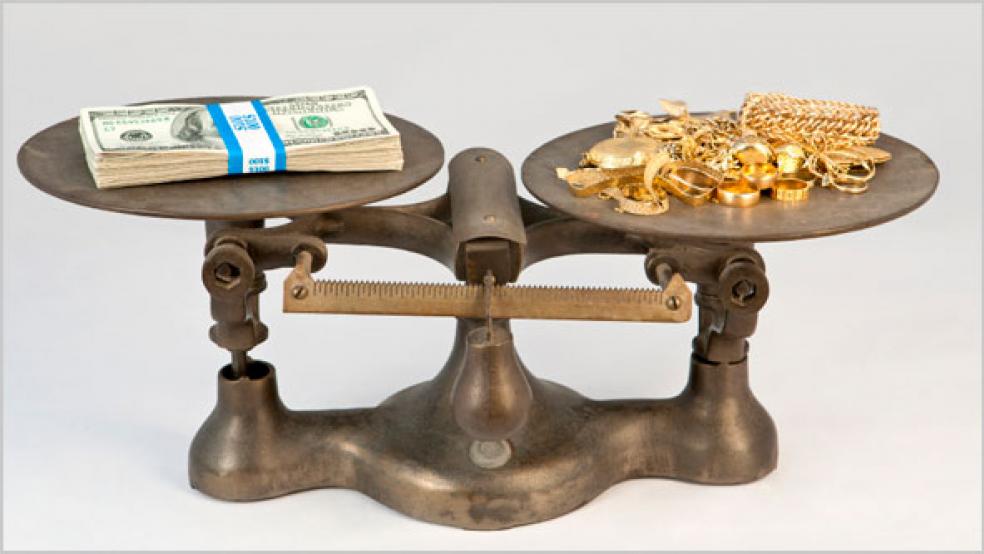Down 635, up 430, down 520. As the Dow Jones Industrial Average swings wildly from day to day in what NYU economist Nouriel Roubini calls a manic depressive market, the sentiment for one segment—gold—has remained consistently euphoric. The price of the precious metal has soared to ever-higher nominal records, briefly topping $1,800 an ounce on Wednesday before settling at $1,788.30.
“It is certainly crystal clear that the investment community is choosing gold as their ‘safe haven’ alternative investment,” notes Mike Daly, senior gold analyst at PFGBest in Chicago.
Gold has soared nearly $150, or 8 percent, in just three days, its biggest advance in that timeframe since November 2008. The metal is up 20 percent since the beginning of July, and now sits some 25 percent below its inflation-adjusted record near $2,400, set back in 1980.
Speculation in the gold market has been so frenzied that commodities exchange operator CME Group said it reached record single-session trade volume on Tuesday, with 504,368 gold futures contracts changing hands, topping the previous record of 469,689 set on July 28 of last year. Late Wednesday, the exchange raised margin requirements for trading a range of gold products, a move that could lead some speculators to sell and lock in their profits.
“I think gold is a little bit overdone,” Rich Ilczyszyn, senior market strategist at MF Global, said even before Wednesday’s jump. “I think you see some of these gold guys that have made $100 to $200 here in a very short amount of time book profit and look for the next pullback to get long.”
Even if gold prices do pull back, though, a host of market conditions suggests that gold won’t lose its shine longer-term. Growing concerns about the stability of the global financial system, paired with record low interest rates for U.S. Treasuries and a weakened dollar, should help ensure a continued appetite for what many investors consider the ultimate safe haven.
Adding to the momentum, central banks in emerging markets have also been shifting into gold, according to a research note published Tuesday by Bank of America Merrill Lynch. “Physical gold is the ultimate collateral because it has no credit risk, so Emerging Market Central Banks have been diversifying their foreign exchange reserves into gold and other non-dollar, non-euro assets in recent quarters,” the bank’s analysts write. That trend is likely to continue in the face of worsening credit quality in the U.S. and Europe, they say. And if, as Wall Street increasingly expects, the U.S. Federal Reserve undertakes another round of quantitative easing, keeping interest rates low, that push into gold should only increase.
Those factors have sent commodities analysts scrambling to boost their target prices for the metal. Goldman Sachs on Sunday boosted its 12-month price target to $1,860 an ounce, and noted that the price could spike even higher: "The recent escalation of sovereign debt concerns suggests that the near-term risk to our new forecast is skewed to the upside, and we continue to recommend long trading positions in gold.”
Not to be outdone, Bank of America Merrill Lynch upped its 12-month price target to $2,000 an ounce. And on Monday—just days after upping their target to $1,800 an ounce—J.P. Morgan analysts Colin Fenton and Jonah Waxman raised their target again, spurred on by Standard & Poor’s downgrade of U.S. debt. “Before the downgrade, our view was that cash gold could average $1800 per oz by year end,” they wrote. “This view will likely now prove to be too conservative: spot gold could drive to $2500 per oz or higher, albeit on very high volatility."





